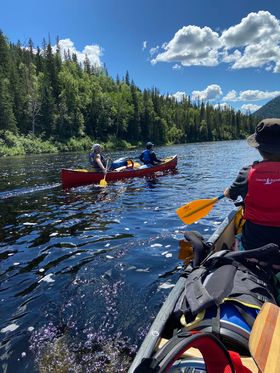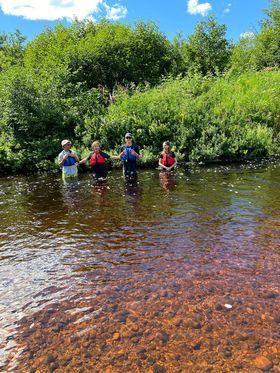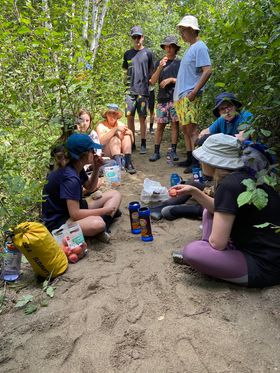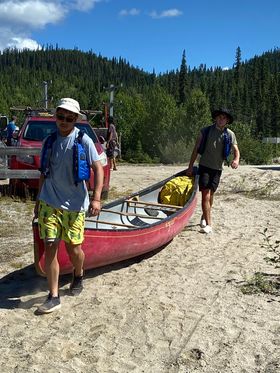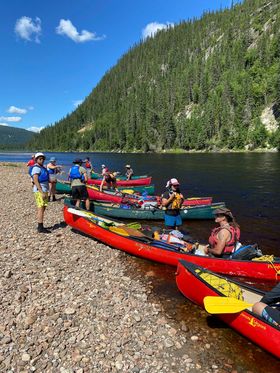Date
Categories
It’s the first real day of expedition, no more becoming familiar with our environment and the basics of canoeing. Today, it’s for real! A long trip to the launching point and a relatively short day on the water afterwards. Finally, on the water, finally in the woods, finally in nature.
This morning, while a journalist and a “camerawoman” were visiting to shoot a news segment to highlight the 25th anniversary of the Foundation, we fill the barrels, making sure we had the essentials in our day bags. Before leaving, final check by Catherine, one of the two facilitators, to check that no one has forgotten anything important, such as a sleeping bag or a ground mattress. It looks as if everyone has what is necessary.
Before getting on the buses, we go through the usual mask and hand disinfectant routine. Then, we fill the buses, count everyone one last time…. And time to leave!
Finally, the prior dread over the 80 kilometres of the forest road is not justified. As Neal, one of the guides and the driver of our minibus, so aptly puts it: “There are many paved roads which are worse than that in many parts of Quebec.”
Once at km 80, we discover a parking lot intended for canoe launching. A steep but sandy slope makes it possible to carry the equipment and the boats down to the river. Catherine calls the groups for the day. Indeed, every day the groups will be different. This will be each day’s surprise, to be revealed the morning before departure. We have lunch in the path next to the boats in the shade, to avoid the direct sunlight, so strong at this time of day.
Slowly, the canoes, all lined up next to each other, fill up and cross the river to the other bank to wait for the last groups. The river is scenic, framed by the boreal forest, with still a good flow. Along the way, we encounter areas of white water that it would be premature to call rapids. But these zones add a bit of spice to an otherwise quiet day.
I spend the afternoon with Samuel, Sam for the group. We discuss among other things, canoeing techniques, how to read a river, where he comes from, and which camps he attended this summer. As the pace of the group is very good, we take a long break on an island. Some of us enjoy a swim with one simple instruction, water above the knees requires a PFD, others make stones ricochet on the water or just chat while contemplating the landscape. From time to time, you can see a cloud of dust on the road overlooking the river. And we leave for the site in the direction of where we will spend the night.
It’s not very long until we get there. A beach covered with river rocks behind which there is a huge sandbank covered with shrubs and low grass. Before everyone goes swimming, Catherine assigns the tasks; they range from collecting firewood for supper and the evening, to setting up latrines, collecting water and purifying it, helping to put up a tarp, and, of course, washing the dishes. Assignment of tasks will also be daily and will be in effect for the duration of stay at a site.
At 5:30 p.m., at a distance and isolated at the end of the beach in the middle of writing, I can still see that all the tents are up, smell the fire, see the tarps of the kitchen site, and feel the calm that has settled after this beautiful busy day.
Tomorrow’s program: a full day on the river. As one of my good friends would say: “There are worse things than that in life!”
– Louis-Étienne Prévost, Blogger and Photographer for the On the Tip of the Toes Foundation
